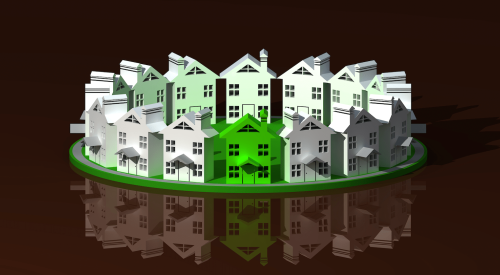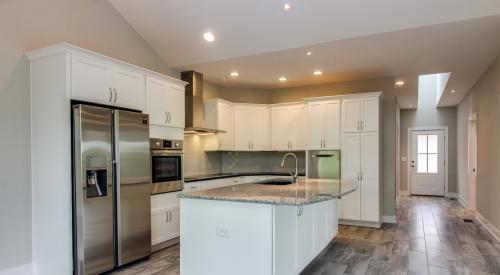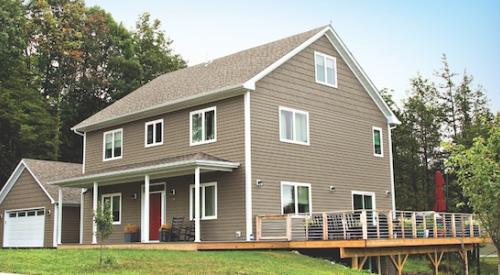Uncle Sam wants you to build energy-efficient homes — and he's willing to pay you $2,000 per house to do it. This is a tax credit, not a deduction, which means you get a full $2,000 per home.
 Homes from Haven Properties in Atlanta have Low-E windows and high levels of insulation. |
During this housing slowdown, every little way to cut costs and improve marketability helps. The federal tax credit not only puts money in your pocket but helps you build energy-efficient homes.
In a 2003 national survey by Harris Interactive, 61 percent of consumers said that energy efficiency is important to them when selecting building products.
How to Earn the Tax CreditTo qualify for the credit, you must build a house whose heating and cooling load efficiency exceeds code by 50 percent. The code referenced by the tax credit is Chapter 4 of the 2004 Supplement to the 2003 Internal Energy Conservation Code (IECC). Code minimum requirements include a 13-SEER air conditioner and a 13-SEER, 7.7-HSPF heat pump.
But the tax credit doesn't allow you to achieve the 50 percent heating and cooling reduction target through HVAC upgrades alone. You must improve the energy efficiency of the building envelope enough to reduce heating and cooling loads by at least 10 percent compared to 2004 IECC. In particular, builders should focus on air-sealing, window performance and insulation levels.
In addition, the home must have been:
- Substantially complete after Aug. 8, 2005
- Purchased between Jan. 1, 2006, and Dec. 31, 2007, for use as a residence
- Certified to meet the energy savings requirements by a qualified third party
To date, the only qualified third party is Home Energy Rating System (HERS) inspectors. (Find inspectors at www.natresnet.org.)
If you build at least 85 homes a year or build subdivisions with the same floor plan using the same subcontractors, you don't need every home inspected. Instead, you only need to test 15 percent of your homes as specified in the Energy Star under Homes Sampling Protocol Guidelines.
For more specific information on what the tax credit requires, read IRS Notice 2006–27 or visit www.energystar.gov.
Beat Code by 50 Percent
If you are one of the more than 3,500 Energy Star builders or build to Energy Star standards, meeting the requirements shouldn't be difficult. If you don't yet build to Energy Star levels, this is a great time to start.
Haven Properties, a medium-sized production builder in Atlanta, builds every one of its homes to Energy Star levels. Haven also certifies every home to the even more stringent standards of EarthCraft House, a green building program of Southface and the Greater Atlanta Home Builders Association.
"It's easy to build an energy-efficient home," says David Milner, vice president and EarthCraft coordinator at Haven. "Just seal the homes up tight and size the equipment properly. We have our HVAC contractor do a Manual J to size the equipment by actual lot orientation, not just the worst case."
All of Haven's houses with basements will qualify for the tax credit.
"In order to meet the 50 percent energy savings threshold of the tax credit, all we had to do was upgrade to 14-SEER units," says Milner.
Several years ago, Haven upgraded to 90-plus efficiency, direct-vent furnaces and water heaters to meet Energy Star and EarthCraft standards. Because these two programs already require third-party inspectors to test the home for energy efficiency, the same inspectors are used to fulfill the tax credit's requirements.
Haven builds energy-efficient homes because it's good for business. Milner says customers view Haven homes as not just having lower energy bills but as being built to a higher standard than other homes. He anticipates that soon all builders will build energy-efficient homes.
"Building energy-efficient homes now keeps us ahead of our competition," Milner says.
Custom builder John Piazza of Piazza Construction in Mount Vernon, Wash., also plans on taking advantage of the tax credit. He is designing a large but comparatively energy-efficient home for a big-game hunter. The home will feature Low-E windows with premium UV blocking ability that helps protect the hides on trophy animals as well as the furniture and floor coverings.
Piazza will build a concrete home with insulating concrete form (ICF) walls that will be about R-50. He chooses ICFs not only for their energy efficiency but also because the metal-encased concrete allows an open floor plan with few posts.
Unlike Haven, Piazza doesn't usually seek certification from a rating system like Energy Star. He'll need to track down a local inspector to certify his home meets the tax credit requirements but says he's not too concerned about this because there are numerous HERS raters in Washington.
Although $2,000 seems small compared to the cost of a high-end home, Piazza still wants the credit. He has been building energy-efficient homes since the 1970s and feels passionately about educating builders and consumers on how and why to build environmentally friendly houses.
"I'd get the tax credit just to prove to people that one, it can be done; two, it's available; and three, more builders should be aware of it," says Piazza. PB
| Author Information |
| Asa Foss writes about better building practices on behalf of the Partnership for Advancing Technology in Housing. PATH is administered by the U.S. Department of Housing and Urban Development. Learn more at www.pathnet.org. |











